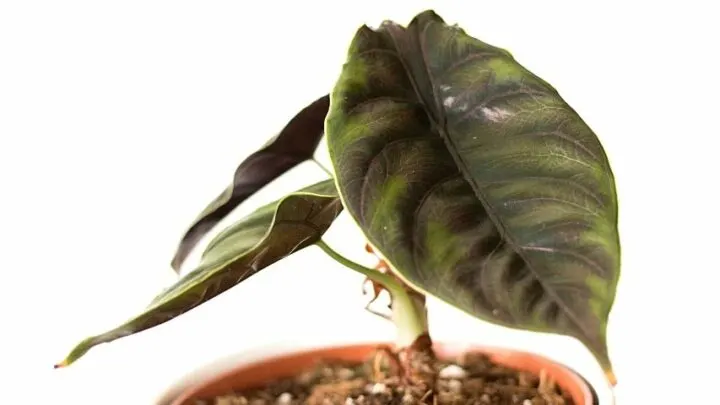One of the prettiest and rarest Alocasias you’ll come across is the Alocasia Azlanii plant.
Also called Red Mambo and Jewel Alocasia, its leaves unfurl gradually as the plant matures.
Although the plant is lovely overall, the main beauty lies in its foliage-colored green with purple to red veins, purple backside, and bright green outlines.
To fully understand what the Alocasia Azlanii plant likes, let’s look at its complete care guide.
This will include its preferred soil type, fertilizer, environment, and other imperative details.
Alocasia Azlanii Plant Care
The Alocasia Azlanii plant enjoys bright, indirect sunlight, well-draining potting mixes, 60% and above humidity, and water every two weeks. Furthermore, when in a temperature range of 65-75 degrees Fahrenheit (18-24 degrees Celsius), the Azlanii plant grows healthy and happy.

Alocasia Azlanii Plant Care
Table of Contents
Alocasia Azlanii Plant Care Guide
Soil
One of the essential components for growing a healthy plant is its soil.
If you have put a plant in its preferred soil type, it is sure to grow at a good rate and is more likely to resist mild infections.
The Alocasia Azlanii plant likes balanced, organic, and well-draining soils that do not hold excess water. I suggest adding perlite or peat moss for extra moisture.
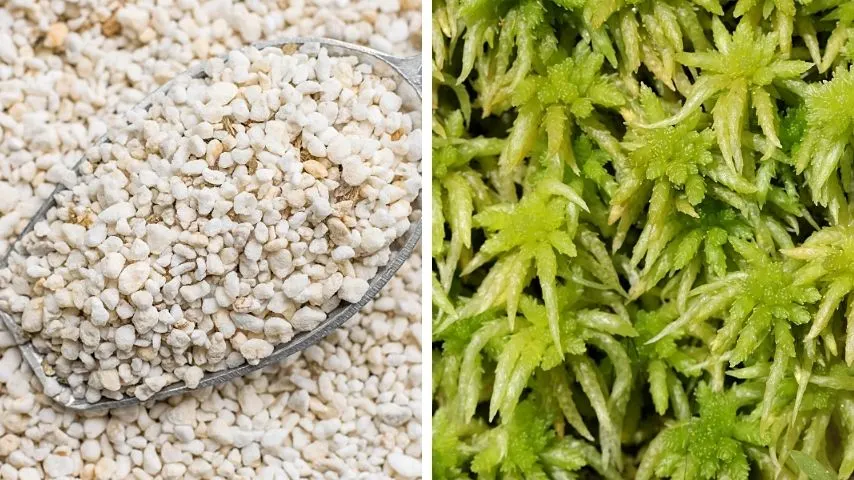
For extra moisture, add perlite or peat moss to your Alocasia Azlanii’s soil
Prepare a two-part potting soil with one-part perlite and one-part coconut husk for an ideal mix.
The Alocasia Azlanii plant’s roots need plenty of oxygen to function efficiently. Therefore, planting it in soil that is constantly wet will compromise the root function, leading to a long list of problems.
What you can do here is check if the soil dries out in a week. If it doesn’t, your Alocasia Azlanii plant’s soil is too wet to be watered again.
Water
When growing the Alocasia Azlanii plant, ensure that it is always moist and not soaked. The finger-dip test is the easiest way to check whether the soil’s dry or wet.
Insert two of your fingers in the Alocasia Azlanii plant’s soil to feel for the remaining moisture.
If the soil seems dry, add water. In contrast, if it is adequately moist, withhold watering until dry again.

Before watering your Alocasia Azlanii, ensure to check the soil for any retained moisture in it
The Alocasia Azlanii plant needs water roughly once every two weeks. But, how long before you water your Alocasia Azlanii again may vary depending on the weather and season.
In the hot and dry seasons, you may have to water the Alocasia Azlanii plant twice, especially if it is outdoors.
But in the winters or rainy seasons, bring the watering frequency to about once or twice a month because the plant will regulate its water levels.
Please make sure that you add lukewarm, chlorine-free water only. Anything too hot or cold may shock the plant.
Light
Like fellow Alocasias, the Alocasia Azlanii plant also does best in bright, indirect sunlight.
West and northeast-facing windows offer the best light as they allow only the needed amount to come into contact with the plant.
The Alocasia Azlanii plant can tolerate a wide range of light levels, even direct light, for a few hours in the morning.
However, this will eventually lead to the burning of foliage or yellow leaves. To avoid such mishaps, place the plant in dappled sunlight only.
If you reside in an apartment with windows offering inadequate or direct light, you can put the Alocasia Azlanii plant under artificial growing lights.
Get a LED full daylight spectrum and position it about 12 inches (30 cm) from the plant for a total of 14 hours a day.
Temperature
The Red Mambo plant is fond of mild temperatures, ranging from 65º to 75º F (18º to 24º C).
This range is of an average household, another reason why the Alocasia Azlanii plant is such a good houseplant.
Although the Alocasia Azlanii plant can withstand a few degrees below and above this range, ideal growth only occurs in the desired temperatures.
The plant is also sensitive to direct drafts of hot and cold wind from heaters and air conditioners. Therefore, place it where there is only moderate air circulation.
Humidity
The humidity factor can make or break things for your Alocasia Azlanii plant. If there is excess moisture, the plant will not only form bizarre-shaped leaves but also lose resistance to the mildest infections.
It is then a lot more likely to be infected by pests and bugs.
On the other hand, if the humidity is inadequate, your Alocasia Azlanii plant will wilt or lose foliage quicker than you understand the cause.
New growth will also be restricted along with stunting of present growth.
Naturally, the Alocasia Azlanii plant enjoys moderate to high humidity. Maintain a temperature range of 60% or higher for a healthy and happy Red Mambo.
If your area is dry, simply mist the plant every other day or install a humidifier that periodically releases vapor.
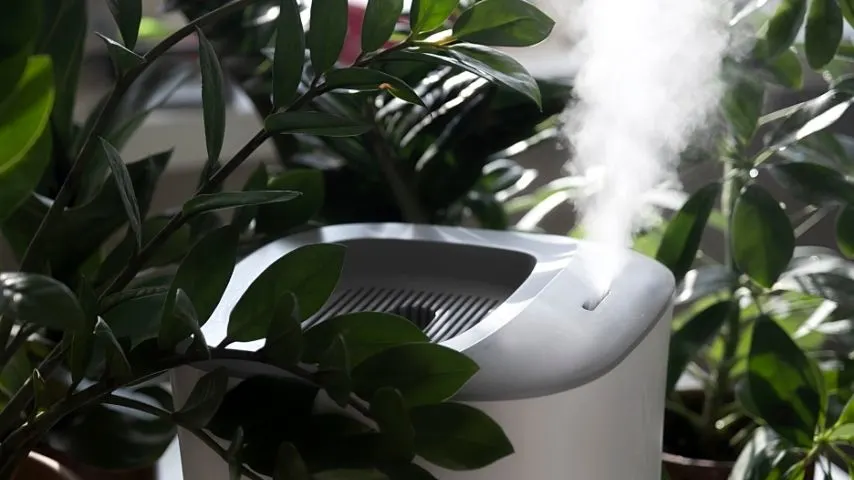
Since your Alocasia Azlanii thrives in a moderate to high humidity environment, install a humidifier
A good indicator of incorrect moisture levels is the curling of leaf edges and brown spots.
If any of these signs appear, immediately rectify your watering routine and humidity level.
Fertilizer
The Alocasia plants are not heavy feeders, so even if you forget to feed them for a week or two, the Alocasia Azlanii plant will manage just fine.
In fact, the Red Mambo plant likes liquid feeds only once a month throughout the spring and summer seasons.
The warm season is when the plant is most active. Therefore, feeding it with a premium-quality NPK fertilizer is essential.
Ensure that the feed has all the necessary macro and micronutrients for your Alocasia Azlanii to grow healthily.
One common mistake gardeners make with liquid fertilizers is that they often pour too much of it as the feed soaks up quickly in the plant’s soil.
Such practices can cause burning of the leaves or nutrient toxicity. To avoid this, use a ½ diluted balanced liquid fertilizer.

Feed your Alocasia Azlanii with a premium-quality liquid fertilizer, but ensure it is diluted
An example of this is that if the feed’s instructions say to use 1 tablespoon per gallon of water, take only ½ tablespoon of the feed and use it every two weeks.
Repotting
The Alocasia Azlanii plant doesn’t need frequent repotting. Thus, even if you don’t change its pot for over a year, the Red Mambo plant will grow just fine.
However, you will probably have to repot and replace its soil after two years.
Another repotting indication is when the roots outgrow the pot or if the Alocasia Azlanii plant catches a serious infection.
In the latter case, treatment should be accompanied by repotting, so there is no chance of recurrence of the infection.
Select a pot 2 inches larger than what the plant previously used. Additionally, make sure that the pot has two or more drainage holes at its bottom.
Pruning
To keep your Alocasia Azlanii plant healthy and attractive, prune it every now and then.
If you see any vines growing haphazardly or they seem infected, grab a pair of pruning scissors and begin removing them. However, please try not to damage the normal vines or any new growth that you see.
Make use of disinfected pruning scissors only to limit the spread of infection. You may use plant-friendly alcohol for cleaning purposes.
Propagation
The Alocasia Azlanii plant is a pretty expensive Alocasia. Thankfully, you can propagate Alocasia Azlanii via divisions, seeds, and offshoots.
Usually, the most successful and the easiest method is division.
1. Roots Division
- Start with carefully taking your plant out of its pot. You may have to shake the roots slightly for them to break free.
- Spray some fungicide or bactericide over the roots to kill any pathogenic organisms.
- Once the spray dries up, split the rhizomes with a disinfected, sharp knife. This segment should have a good number of roots.
- Next, put this segment in a small pot with a good and well-draining potting mix. The pot should have some draining holes.
- Pour some water and fix the potting mix around the plant to stabilize it.
2. Offshoots
You can use the Alocasia Azlanii plant’s offshoots for propagation, as they are small versions of it and grow throughout the year.
You need to cut some of the mother plant’s roots with scissors for this method. Replant this baby plant in a pot with the ideal potting mix.
3. Seeds
The Alocasia Azlanii plant’s seeds should be soaked in water overnight in distilled, warm water. Sow the seeds about 0.5 inches (1 cm) in the soil the following day, preferably in the fall season.
Water the seeds lightly for moisture and cover them with a plastic bag.
Move the plant in dappled sunlight while keeping the plant moist. Leave the plant till you see some new growth.
Furthermore, you can add a heat mat under the containers to keep the Alocasia Azlanii’s seedlings warm.
After a few months, the seedlings will grow to a height of 2 inches or 5 centimeters. This is the ideal time to transplant them into a bigger pot while minimizing any damage to the roots.
Blooms
The Alocasia Azlanii plant is primarily grown for its lovely foliage and overall looks. The blooms may occur in the peak growing seasons.
If the flowers spring out in the center, handpick them or remove them with pruners so that the plant can direct more of its energy towards new growth.
Growth
The Red Mambo plant actively grows in USDA hardiness zones 7 through 11, where the temperatures are mild, and humidity is ample.
In about 60% and higher moisture levels, the Alocasia Azlanii plant attains a height of approximately 24 inches feet (60 cm) and 12 inches (30 cm) width.
Similarly, the leaves grow 8 inches (20 cm) long in bright, filtered sunlight.
Common Problems for Alocasia Azlanii
Spider Mites
These are small bugs invisible to the naked eye that frequently feed on the Alocasia Azlanii plant. They can spread through an infected plant or even your shoes or clothes.
They won’t cause any harm to humans but may become a nightmare for plants.
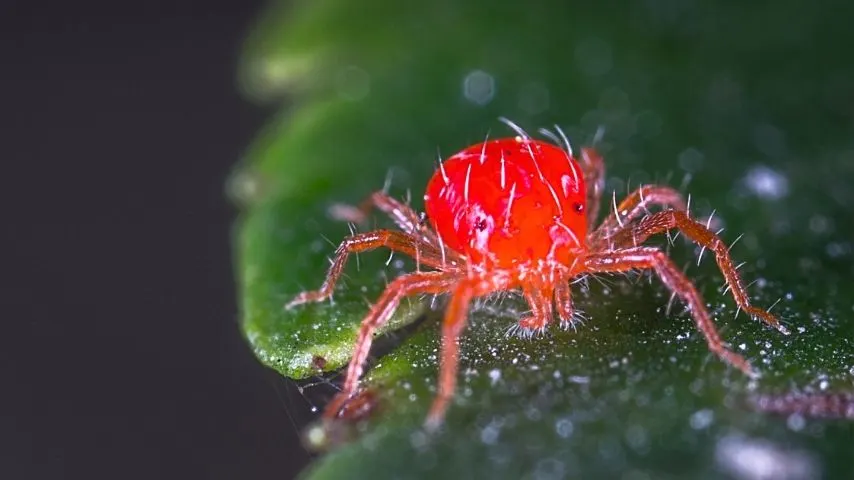
When your Alocasia Azlanii’s infested with spider mites, you’ll see yellow or brown spots forming on its leaves
Spider mites can even survive debugging, as you need special glasses to spot them.
Attracted by dry and warm conditions, these bugs form yellow or brown spots on the leaves, stripping the plant of its nutrients. Webbing is another major sign of spider mites.
To eliminate them, treat your Alocasia Azlanii plant with neem oil or spray a pesticide all over the plant, especially the foliage.
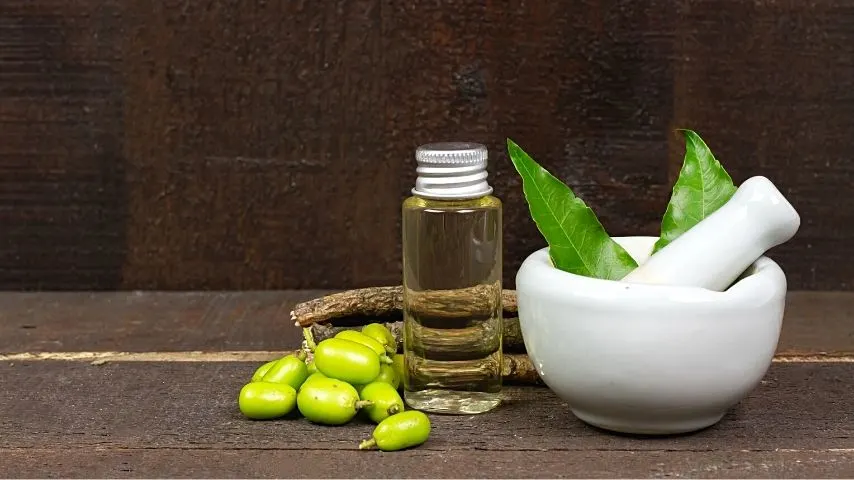
Treating your spider mite-infested Alocasia Azlanii with neem oil helps in eliminating the pests
Moreover, do not let the plant dry out and maintain adequate moisture levels.
Aphids
A larger enemy of your Alocasia Azlanii plant is Aphids. These are small bugs with an appearance of a green or blackfly.
They suck sap, quickly weakening the Alocasia Azlanii plant’s entire transport system. The plant can no longer provide for its usual functions due to extreme nutrient depletion.
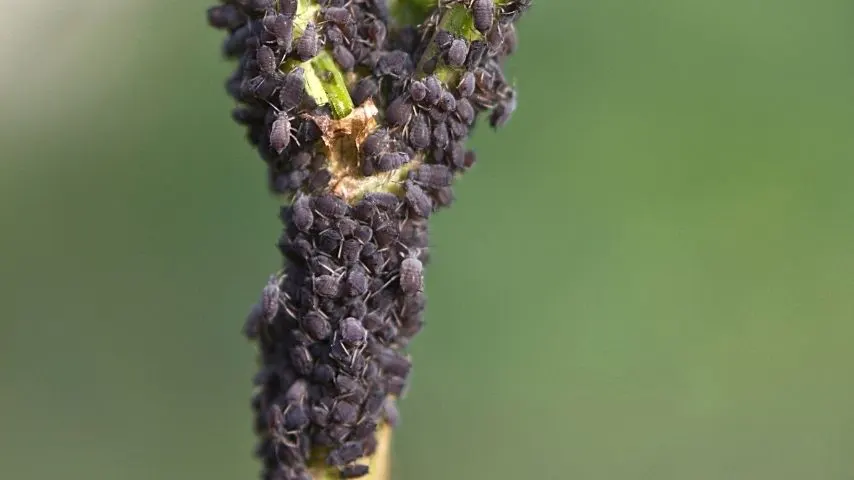
Aphids is another plant pest that can affect your Alocasia Azlanii
Aphids also cause withering and death in extreme cases. They leave behind a honeydew, which quickly becomes a medium for sooty molds that further impair the photosynthesis process and encourage fungal growth.
To get rid of Aphids, you need to bring out all your insecticidal sprays and oils, including neem oil. Other oil options include plant-derived oils and horticultural soils, such as canola oil.
Use these all over the plant to smother these destructive bugs. But please ensure that do a thorough coverage to kill all the aphids and their eggs.
Root Rot
What keeps the plant functioning is its roots. If they undergo rooting, the plant is pretty much doomed.
Root rot will present with various signs, such as damp soil, yellowing or discolored leaves, and stunted growth. Likewise, you may notice a mushy stem, foul odor, or dropping.
To treat the Alocasia Azlanii plant with root rot, apply a fungicide all over it.
Drench the soil and roots in it twice for at least two weeks until you see new healthy foliage again.
Tips for Growing Alocasia Azlanii
- Grow it in bright, dappled sunlight.
- Plant in well-draining, rich soils with peat moss or perlite.
- Only water when the soil’s top 2 inches run dry.
- Maintain a temperature range of 65º to 75º F.
- Keep the humidity level over 60% for optimal growth.
Frequently Asked Questions about Alocasia Azlanii Plant Care
Why is my Alocasia Azlanii plant drooping?
Drooping leaves are often the result of underwatering. Do not withhold water for too long as it will also promote aphids infestation along with drooping. Water the Alocasia Azlanii once in a fortnight or every 2 weeks or when the topsoil layer runs dry.
Why is my Alocasia Azlanii plant dropping leaves?
A frequent cause of Alocasia Azlanii dropping leaves is over and underwatering. Maintain an ideal watering schedule to prevent this.
Is the Alocasia Azlanii plant toxic?
The Alocasia Azlanii plant’s all parts contain calcium oxalate crystals, which cause oral and esophageal irritation if ingested. Therefore, keep the Alocasia Azlanii away from both kids and pets.
Conclusion
The Alocasia Azlanii plant is an excellent choice for those looking for low-maintenance plants to grow.
All it needs is bright, dappled sunlight, watering once every two weeks, and high moisture to thrive.
Keep this beauty away from pets and children to avoid any unforeseen mishaps.

Daniel has been a plant enthusiast for over 20 years. He owns hundreds of houseplants and prepares for the chili growing seasons yearly with great anticipation. His favorite plants are plant species in the Araceae family, such as Monstera, Philodendron, and Anthurium. He also loves gardening and is growing hot peppers, tomatoes, and many more vegetables.

